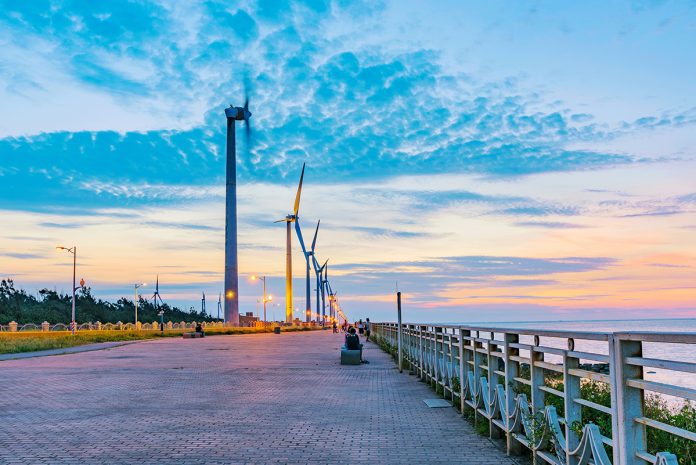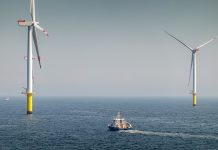Dr. Gwo-shyh Song, Associate Professor at the Institute of Oceanography, National Taiwan University and Senior Consultant with Global Aqua Survey Ltd provides an in-depth look at green energy in the country
Taiwan, an island-type country with a population density ranked second in the world, must be provided with approximately 42GW electricity autonomously each year. In 2017, power distribution for coal-fired power generation was 39.2%, gas power generation 43.4%, nuclear power generation 9.3%, hydroelectric power generation 8.1% (plus a few percentages on renewable energy).
Recently, a rise in the awareness of environmental protection, under the anti-nuclear policy of the Taiwan Government ruling by the Democratic Progress Party, and peoples’ awareness of anti-air pollution resulting from thermal power generation, wind power seems to be the major antidote to this impasse in energy distribution.
Due to land wind turbines, in addition to its poor efficiency, its development has also been limited by land use and the turbine’s low-frequency noise. Hence, since 2012, the government had promoted the so-called offshore wind power scheme for thousands of turbines. Coupled with the mature development of offshore wind farm in Europe, such as the significant reduction of costs due to the maturation of development technology, Taiwan has now become the most important area in the world to develop offshore wind power generation.
The wind field in Taiwan Strait is blessed in the world, for instance; the average density of wind fields near the coastal zone of Changhua is 7m/s or equal to 750W per square metre of power generation. According to C-Offshore reporting, Taiwan Strait ranks among the highest wind farms in the world. The development of offshore wind power in the Strait area has the following characteristics:
- Wind speed greater than 10m/s, a good rate of more than 60% in 7.5 months during the autumn and winter season; even a proper rate of more than 20% in 4.5 months during the spring and summer season. More importantly, the direction of the wind is stable.
- Water depth of less than 50 metres can be developed in a wide area of up to 5,600 square kilometres.
- More than 80% of wind farm positions have a moderate offshore distance to reduce the impact on the inshore environment.
- With the exception of some inshore wind fields, most of the wind farm geological conditions of the excellent seabed are covered by more than a hundred metre thick layers of a medium or coarse grain of sands without the occurrence of active faults.
- The government is encouraging a push to reduce fisheries disruption.
Promoting green energy is the main mechanism to solve the environmental impact in the development of modern world inspections, and while it is expensive, Taiwan cannot stay out of it. However, the development of offshore wind power based on national economic considerations must also take into account the following shocks:
-
Impact and myths of the environment
Is it time to use nuclear energy but it this causing much disturbance in Taiwan because it is a relatively cheap and stable base power in energy distribution? Many people are opposed to nuclear power because of Taiwan’s location in earthquake zones – combined with the incidence of Japan’s Fukushima tsunami nuclear power plant disaster and nuclear waste which has not been resolved – so this makes the residents who live around power plants feel unsafe. The government has, therefore, decided to gradually reduce the power supply ratio of nuclear energy, with the intention to denuclearisation the country in 2025.
The supply ratio of thermal power generation must be increased in a short period of time without the use of nuclear power. Although the cost of thermal generating electricity is cheaper – especially coal-fired power generation, releasing pollution particles also called particulate matter (PM) 2.5 – makes almost all major metro-cities with bad air quality such that people choose against the additional development of so-called coal-fired power plants during the 2018 referendum.
As for the construction of hydroelectric power or reservoirs, it has caused the destruction of the natural environment or results in reservoir siltation and river ecological damage, and even coastal erosion phenomenon. The establishment of terrestrial wind turbines in recent years because of the low-frequency noise has been generated but its development has been limited.
So, it seems that offshore wind power is the antidote to environmental killers compared with other types of power resource. The impact on the migration of migratory birds and the restrictions on fishing activities were the most discussed when I was on the Environmental Impact Assessment Committee; however, it had also been suggested that the agglomeration effect of the foundation of the turbines based on the seabed may have a positive effect on the increase in catches.
-
Power generation efficiency and cost
Regardless of whether wind power can be used as base power, the demand for existing electricity in Taiwan was 42GW in 2018. If the average generating capacity per turbine is 8 MW, then half of the wind field area of 5,600 square kilometres for offshore wind power generation is used and spacing between the turbines is 1 km. 22.4GW power of electricity can be generated in ten years which is more than half of the amount of power required in Taiwan.
Wind turbines can generate power at a wind speed of 3m/s. It indicates that there will be 97% of the time period in the Strait Wind Power can be generated. With larger wind energy based on higher wind speed, we can predict that it can generate 60% of the total electricity that is produced by offshore wind turbines during the autumn and winter; or at least 20% of the total wind-generated electricity in the summer season. It indicates that in 2030, with the total wind-generated power at 22.4GW, there is 13.44GW which can be generated or accounts for about one-third of the electricity demand during winter, and 4.5GW can be generated or accounts for 11% of electricity demand in the summer. This amount of power generation can replace the electricity generated by nuclear power in Taiwan or reduce the amount of air pollution emitted by coal-fired power generated by 30% in the summer when the air is more heavily polluted.
To encourage skilled developers to assist in the initial development of offshore wind electricity, Taiwan has provided approximately the purchase price of NTD 6 dollars per degree (exchange ratio between NTD and USD is 31:1). This electricity price is much higher than the average cost of generating electricity for the Taiwan Power Company (TPC) itself, NTD 2.2. As a result, many groups of people have questioned the offshore wind power policy which will greatly raise the cost of power generation and, therefore, cause prices to rise and will impact on the overall economic development of Taiwan.
But will the development of offshore wind power really end up like this? Before we can come to this conclusion, we must first observe the following two phenomena:
a). This initial pricing was only applicable to the development of demonstration wind farms, a price that would slowly decline with the status of development. The 5.5GW wind farm granted to date, of which 3.3GW has been used in terms of the average purchase price that has to be supplied before 2025 has fallen to NTD 5.4- NTD 5.8 per degree. The remaining 2.2GW wind farms granted with the open bidding has dropped to a reasonable price of NTD 2.2 – NTD 2.5 per degree. It comes to the average purchase price of 5.5GW for wind farms, dropping to around NTD 4.5 per degree.
b). The ratio of power energy types in the Taiwan Power Company has a different energy cost structure. With the removal of environmental costs, coal-fired power generation cost is NTD 1.6, gas power is NTD 2.7, nuclear power is NTD 1.2, hydroelectric power is NTD 2.7, and terrestrial wind power is NTD 0.8 degree (above of them is non-procurement costs).
Hence, when considering the different costs at various times and in terms of the different energy structure of power supply, the costs of power generation in Taiwan will be increased by between 12%-15%, based on the use of offshore wind power calculations. Finally, it will be reflected in the pricing of electricity.
So, let’s make a preliminary budget estimate. Nuclear power generation in Taiwan was around 4GW in 2018 as part of the government’s strategy: offshore wind power is used to replace nuclear power generation. The remainder of wind power should replace high-pollution coal-fired power generation.
According to the time schedule of offshore wind power development, 5.5GW of wind power can be supplied by 2025, and 10.8GW (EIA obtained by existing developers) by 2030. Let’s assume the generating costs of offshore wind power are NTD 4.5 per degree for the first 5.5GW, and NTD 2.3 per degree for the remainder of 5.3GW, then electricity generation costs will be in between NTD 2.47 and NTD 2.53 per degree. Compared with the costs of NTD 2.2 in 2018, an increase of between 12%-15% in the pricing of electricity is predicted.
In summary, under the condition that 10.8GW wind power can supply 5.4GW electricity by assuming there is 50% proper rate in a year – wind power can totally replace the nuclear power used or one-third of high-polluted coal-fired power in Taiwan between 2025 and 2030. However, electricity prices will rise by at least 10% which will impact individuals in the country.
3. Benefits for local industry
The purchase price for high-priced wind power proposed by the government in Taiwan totals USD 160 million worth of investment for 3.3GW of power by foreigner developers, who were asked to come up with a so-called home-grown industry chain mentoring programme. This means that requiring local industries to participate in the construction process is necessary. Projects include work on the fan tower, turbine and its components, the underwater foundation, basic power facilities, the electric cable and the laying, underwater construction, hydrographic and geological site surveys, as well as the manufacture of ship and tools which all must be done locally.
The plan aims to utilise hundreds of millions of investment to increase the country’s economic growth by providing employment opportunities for thousands of people in Taiwan. Besides that, its final goal is to ensure the localisation of wind power industrial technology.
Because the development of offshore wind power concerns the cost of generating electricity in Taiwan, the increase in NTD 0.3 per degree was predicted on the total at 42GW of the power supply. It means that the country will spend more around NTD 110 billion (USD 3.3 billion) per year; therefore, the plan has been criticised by many since the 20 years’ wind power supply plan will cost the people of the country around NTD 2,200 billion of extra money (USD 70 billion). The rise of local industries and the roots of technology have become the major antidote to this controversy.
So far, developers from all over the world are DONG Energy (or Orsted) from Denmark, Yushen from Singapore, Northpower from Canada, Macquarie Capital from Austria, Copenhagen Infrastructure Partners (CIP) from Denmark, WPD from Germany; and includes some local businesses, such as Swancor Holding Co, China Steel Corp and Asia Cement Corp. This is because the development of green energy has already reached a global consensus.
In addition, this is the best time for Taiwan to develop offshore wind power. Since the development of wind power in European counties for many years, the accumulation of this huge breadth of experience is such that Taiwan could fall into the trap of not taking the right approach. Together with strong support from the Taiwan Government, it then brought the wind power developers from all over the world successively.
Based on the protection of the Earth’s environment, although the cost of offshore wind power construction is relatively high at this stage, in recent years, with mature technology in place, experts predict that the costs per degree of offshore wind power in
Asia will be less than NTD 2 dollars. Of the top 20, Taiwan Strait has been blessing by the 16 best wind fields in the world; therefore, the promotion of offshore wind power in the face of non-nuclear homes and a reduction of air pollution, I believe that Taiwan is on the right track.
Whether this precious energy, located in Taiwan Strait, can give Taiwan a bright future in the next few years as a model for the world’s environmental leader, let’s wait and see.
Please note: This is a commercial profile
Dr. Gwo-shyh Song
Associate Professor
Institute of Oceanography,
National Taiwan University
Senior Consultant
Global Aqua Survey Ltd.
Tel: +886 02 23660883











